This page presents general review Land cruiser: price, photo, technical characteristics and history of the SUV. Story Toyota Land The Cruiser began with the 1953 BJ-series Toyota Jeep, with "B" for engine type and "J" for Jeep. After the release of the Toyota BJ, a number of complaints and dissatisfaction rained down: the jeep was originally invented by the Willys Company. It was then that the name of the world-famous all-terrain vehicle Toyota Land Cruiser was born, which means “land cruiser” in translation.
The first Tayota Land Cruiser SUVs with a small body and a convertible top were designed to transport goods and people.
Car first Toyota Land Cruiser was built for military purposes, which explained the poor elaboration of its interior and design. The desire of the Japanese to expand in the world market prompted them to improve the chassis and interior of the off-road vehicle.
The Land Cruiser BJ 20 series, dated 1955, had increased driving comfort and a different appearance: now there are more streamlined lines in the corporate body design. The updated Toyota Land Cruiser SUV began to actively move into foreign car markets. Concerning technical equipment Toyota Land Cruiser, the models had such a drawback as the absence of a reduced range in the transmission. In addition, the first gear was designed too low in order to pull away at maximum load.
In 1960, the Toyota Land Cruiser, the equipment of which was significantly improved, received a reduction range in the transmission. Now the functionality of the machine in difficult off-road conditions under maximum loads has been increased. Motor power Toyota models The Land Cruiser of the twentieth series was equal to 105 horsepower, and the engine of the Land Cruiser 40 series car developed 125 hp. with.
In the early 80s, the 60th series of Land Cruiser cars came out with a new engine under the hood of the 2H type, which was aggregated with an automatic transmission. For Japan, this was the latest achievement in the field of SUVs.
The seventieth series of the Toyota Land Cruiser was released in the fall of 1984, ending an entire era. In addition to the two-door body, a four-door Land Cruiser was built, called the Prado. The design of the Land Cruiser Prado had its own unique style: the eight-seater model was equipped with three rows of seats.
Cars Land Cruiser 80 series, released in 1990, were conceived as a field for the active application of the latest technological developments. The emergence of new comfort elements in the Land Cruiser was stimulated by competition with. So the Toyota Land Cruiser 80 off-road vehicle became a true breakthrough in Japanese practical car design.
In 1996, the 90-series SUV with independent front suspension appeared, which provoked an unprecedented success in the world market. At the end of 1997, the premiere of the luxury model Toyota Land Cruiser 100 took place, which was driven by 4.5- and 4.7-liter "sixes" and "eights". The basis for creating this model was borrowed from the American. The novelty differed from it more powerful engine(up to 250 Horse power), independent suspension and richer interior decoration. The main disadvantage of the "hundredth" Land Cruiser is overheating and brake wear.
In 2002, the Toyota Land Cruiser 100 underwent a slight upgrade, as a result of which the bumpers, headlights, and interior design changed.
Five years later, the model line was replenished with the Toyota Land Cruiser 200 model, one of the most popular today. In 2012, this SUV was restyled.
The "crawl control" mode allows you to overcome steep ascents and descents without difficulty, which increases the value of Toyota Land Cruiser in the eyes of wealthy and enthusiastic travelers. As evidenced by numerous reviews, the Land Cruiser can safely drive up a small hill at idle. Do not be afraid to hook the bumper on any obstacle on the way, because it is forty cm from the ground.
The interior of the Land Cruiser, whose equipment is luxury by default, has many options. Each passenger can independently manage the climate control, as well as make individual seat heating. A powerful freezer box was placed between the front seats. Ahead is a board computer with a navigator. The driver's and front passenger's seats, as well as the steering wheel, are equipped with an electric drive. True, the congestion of the front console buttons sometimes confuses the driver.
Toyota Land Cruiser - price
Another drawback of the “two hundredth” Land Cruiser model is the price, which starts at three million two hundred thousand rubles. Alas, many fans of the Toyota Land Cruiser are not satisfied with the cost of the “two hundred”. It would seem that the price of Toyota Land Cruiser Prado almost twice less. However, the following feature should be taken into account: the equipment of all “two hundred” is luxury by default. If you take all the same options on the Prado, then the price of the Toyota Land Cruiser 200 will turn out to be only two hundred thousand higher.
At the top diesel modification Toyota Land Cruiser cost is three and a half million.
Toyota engineers thought about the production of their first SUV at the end of the forties of the last century, and in 1950 the development of such a car began. A year later, Toyota BJ was born - the Japanese analogue of the American Willys Jeep. The novelty was created primarily for military purposes.
The SUV, driven by a 3.4-liter engine with 85 hp, turned out to be very strong thanks to elements borrowed from trucks, and brilliantly showed itself off-road. The power unit was paired with a 3-speed manual transmission. Downshifting on BJ, unlike the "Willis", was not provided.
2nd generation, 1955–1960
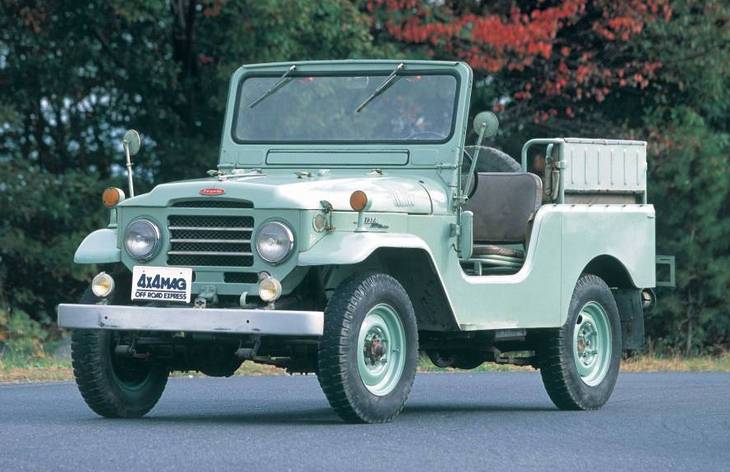
When creating the second generation of the SUV, Toyota specialists focused on increased comfort and a more attractive, civilian appearance. The exterior lines have become more streamlined, and the interior, which has become more spacious, has acquired air conditioning and a heater.
Under the hood of the car, at first, there was an engine from BJ, and then it was replaced new motor Toyota F with a volume of 3.9 liters, which at first produced 105 “horses”, and a little later 125.
Since 1956, cars of the 20 series began to be exported. From that moment on, the SUV received the name Land Cruiser, which means "land cruiser". The 20 series had several versions with different bodies and wheelbases.
3rd generation, 1960–1984
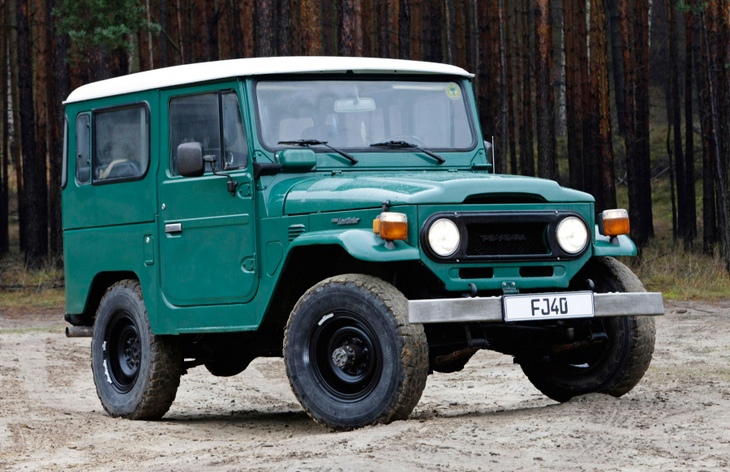
Following Generation Land Cruiser outwardly remained approximately the same as its predecessor - the design turned out to be so successful.
In technical terms, there were more changes. Firstly, a downshift finally appeared, and secondly, in motor range diesel units from 3.0 to 3.6 liters were added to the F engine from the 20 series. The transmission was represented by a 3-speed "mechanics", and since 1974 - a 4-speed.
"Cruiser" fell in love with buyers in all countries and quickly gained popularity, and at one time was generally the best-selling car in the United States. The 40th was produced for 24 years.
4th generation, 1967–1979
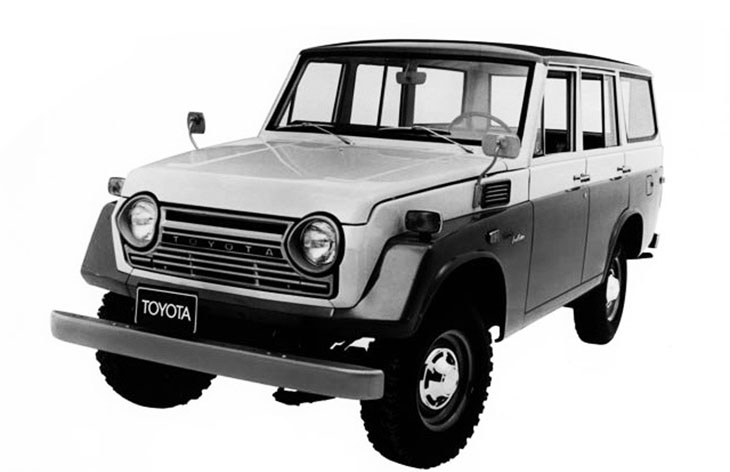
In the "Cruiser" of the 55th series, special attention was paid to comfort. The SUV, as before built on a solid frame, has grown significantly, and in terms of the convenience of the interior, it resembled a passenger car.
Among the available power units, a 4.2-liter 2F engine appeared, whose power was 135 hp. This Land Cruiser was the first in the line, which was called Comfort-oriented.
5th generation, 1980–1989

The development of the successor to the LC 55 started back in 1976 under the leadership of Hiroshi Osawa, and made its public debut 4 years later.
The 60 series SUV had impressive dimensions compared to its predecessors - the wheelbase was 2730 mm, and the third row of seats fit in the cabin. The spring suspension has become much softer than before, and comfortable seats with improved lateral support and power windows created an even greater atmosphere of comfort. The palette of engines was a 4.2-liter gasoline "engine" and a 4.0-liter "diesel", and both included 137 "horses". At the beginning of sales, another less powerful one was available diesel unit volume of 3.4 liters. A 5-speed "mechanics" was considered the basic transmission, and in 1984 a 4-band "automatic" became available for the first time.
In 1987, the model underwent a slight restyling, which gave the Land Cruiser 60 new paint options, wider wheels and square twin headlights instead of single round ones.
6th generation, 1984

Land Cruiser 70 is the direct successor of the "fortieth" and the last truly off-road "Cruiser". For him, the main priority is not comfort and luxury, but cross-country ability and reliability. Two and four-door versions were sold, the second of which was named Prado. By 1990, "" became an independent model.
In a modernized form, the car is still produced. SUVs and Toyota pickups The Land Cruiser 70 is offered in Japan, Australia and some other markets. The machine is equipped with a 4.2-liter atmospheric diesel engine (131 hp) and a 4.0-liter gasoline engine (228 hp)
7th generation, 1990–1997
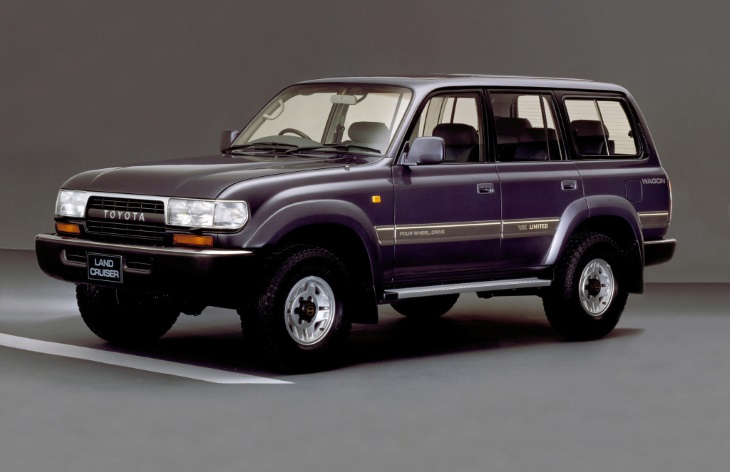
Introduced in 1990, the new LC 80 could not be confused with anything else - the designers gave it a completely new appearance with a lot of rounded lines and other details that made the novelty look very fresh.
The SUV had electronically controlled locks for all differentials - two interwheel and interaxle. For bringing the "cruiser" into motion, petrol 4.0 and 4.5-liter engines, as well as "diesel" and "turbodiesel" with the same volume of 4.2 liters, were responsible for the choice. Engine power ranged from 130 to 215 "horses". The engineers also took care of safety - 2 airbags and ABS were already provided in the base.
Navigation sections by car
Toyota Land Cruiser history
There are several series of Land Cruiser cars - the 20th, 40th, 60th, 70th, 80th, 90th and, of course, the 100th.
And so, starting in 1960, the history of the development of the 40th series of this car begins. At this time, an evolutionary stage in the development of the automotive industry took place. Old technologies have been upgraded and changed, such as the panel assembly process. To improve the behavior of the car in off-road conditions, a lowering row was introduced into the transmission, which also significantly contributed to the improvement of the car's performance under heavy loads. closer to dashboard the control lever is located transfer box, and the gearshift lever was completely brought to steering column, so that there was more space on the floor and now three passengers could be accommodated in front.
The power of the motor type B of the 20th series at that time was only 105 hp, and the 40th series 125 hp, however, the power of the latter was increased to 130 hp.
To increase the rear view, windows were added to the general glazing of the body in the corners of the rear of the body, this particular feature is that distinguishing feature, inherent in the 40th series of Land Cruiser.
1974 is marked by the appearance diesel vehicles Land Cruiser with a B-type engine and a larger displacement, which now began to be 3 liters, while before it was only 2.8 liters. Nevertheless, such cars fell into the compact class, and their owners were able to pay less tax, and the maintenance of such a car was not expensive. All this created the conditions for a significant increase in the number of people who, in any case, could afford the maintenance of such an SUV.
The sale of the 40th series lasted as much as 24 years, until the 70th came to replace this series. The exterior of the car has not undergone any special changes, but the insides have been constantly improved. Nowadays, finding a 40-series SUV on the market in good condition is unlikely to succeed, because their production has long been discontinued, but, nevertheless, many cars, although quite hackneyed, are still on the move.
The 60th series began to be developed in 1976 under the leadership of Hiroshi Osawa, the chief engineer of Toyota. The debut of this series took place in 1980. In terms of configuration, it was very similar to the 40th, already familiar to everyone, dependent spring suspension, but the first modifications were completely equipped with the same engines and gearboxes.
But already in 1982, big changes took place, the HJ60 car came out, which was equipped with diesel engine type 2H with six cylinders, a volume of 3980 cm3. This car turned out to be both powerful and comfortable at the same time, all these positive properties were provided by a volumetric engine, a significant height of the roof of the body, mechanical five-speed gearbox gearshift or four-speed automatic, power sunroof, mirrors with function remote control etc. Five years later, in 1987, the appearance of the cars of the 60th series was somewhat changed: instead of two round headlights, four were installed, but square ones, the body design became somewhat more colorful, and one cannot but note the new wide tires. It was with this series that the transformation of the Land Cruiser car from a semi-military into a rather comfortable passenger car began. This is one of the clearest examples. It was this series that became the prototype for newer models from the 80th and 100th series.
November 1984 was the month of the introduction of the all-new 70 Series, which ended what could be called an entire line of Land Cruisers from the 20 Series onwards. This era lasted as long as 29 years, during which time the 40th series did not receive significant changes. The company's engineers were busy developing new models that would combine the traditional high strength and endurance with the latest technology inherent in the most modern cars. In this regard, it was decided to continue using the familiar design, which consisted of a ladder-type frame and a suspension consisting of semi-elliptical springs, this design has long proven itself from the best side. Of the innovations, one of the most significant was an increase in the thickness of body panels by 1 mm.
The production of two modifications of this car was launched: the BJ70 version with a shortened base, all-metal bodies and a canvas top, the second version of the BJ73 is medium-base, its top is made of plastic.
Since 1990, two new 1PZ (gasoline) engines have been offered for cars of the 70th series, it replaced the five-cylinder 3B engine with a volume of 3469 cc. cm, 115 hp the second updated diesel engine 1HZ, which replaced the old six-cylinder 13V-T with a capacity of 135 hp. and a volume of 4163 cubic meters. cm.
The main frame members on the 40 and 50 series were riveted together, while the new LandCruiser 70 uses laser welding to connect the various members, making the car's structure even stronger.
Toyota Corporation specialists constantly tried to modernize existing models. The engine, suspension and interior equipment were subject to changes. Although it is worth noting that in the early versions of the Land Cruiser, under no circumstances were sacrificed driving performance and reliability due to design changes and increased comfort.
But over time, the concept of the company has changed. Now the main percentage of buyers of such cars are city dwellers, and they rarely have to operate their iron horses in difficult off-road conditions, they usually drive on ideal roads. In this regard, the company's engineers are now simply obliged to pay more attention to the comfort of the driver and passengers, now the spoiled buyer, in addition to excellent cross-country ability, also wants to receive various auxiliary options and devices, such as climate control, leather upholstery, etc.
And so, October 1989 was the month of the debut of a new generation of the car - Toyota Land Cruiser 80. Now the contours of the car were more rounded, the frame and bodies were now even tougher, but you can write a separate article about all kinds of stuffing. For buyers, the car was presented in three versions, from the most common - STD, to the fancy VX.
What can I say, due to its simplicity, but traditional reliability, many militaries of various countries used the 80 STD as an army jeep. This version, unlike the other two, had a minimum of electronics, there is no ABS that is afraid of dirt and other electronic systems. But an optional winch could be installed, which could withstand a maximum force of 4 tons, which was clearly not superfluous when driving on the strongest off-road. Even the most extreme conditions could not tame the Land Cruiser 80 STD.
And now The 80 GX is a comfortable car. The model could be equipped with a choice of two engines - a six-cylinder 130-horsepower diesel engine with a volume of 4.2 liters, or also a six-cylinder gasoline engine with a volume of 4.5 liters and a power of 213 hp.
And of course the third version - 80 VX - a luxury car, equipped with the most modern devices and options at that time. The most powerful engines were installed on the car - a turbodiesel and injection gasoline engine.
In total there were three types of engine that could be installed on cars of the 80th series 1HZ (diesel), 1HD-T (turbo-diesel with direct fuel injection) and, of course, 3F-E (petrol unit). Despite several modifications, absolutely all cars of this series had a spring suspension for all pairs of wheels. Also, almost all cars had permanent all-wheel drive, with the exception of a small number of cars that had front-wheel drive was made disabled.
In 1996, there was a slight change in the configuration of cars, now all of them, without exception, began to be equipped with front airbags and anti-lock brakes (ABS).
And already in 1998 the debut took place new version Land Cruiser - Land Cruiser 100. When creating this car, all the experience of the corporation, accumulated over many years of creating and producing excellent cars, was involved. The model was presented to the general public in Chicago at a well-known show, but Europe was able to get acquainted with the novelty in the same year at an exhibition in Geneva.
The new version has become a little larger than the previous one, so the length has increased by 90 mm, the width has also increased slightly, and with it there has been an increase in the track. Thanks to this increase, the interior has become even more spacious and comfortable. Due to the increased dimensions, the engineers had to increase the rigidity of the body, and they succeeded, the car became 50% stiffer than its predecessor.
Increased and longitudinal and transverse, and diagonal rigidity, this became possible due to the use of steel sheets with a variable profile, as well as some other elements that helped to strengthen the structure. Those parts of the car, on which the likelihood of corrosion is especially high, are covered with special sheets of stainless steel.
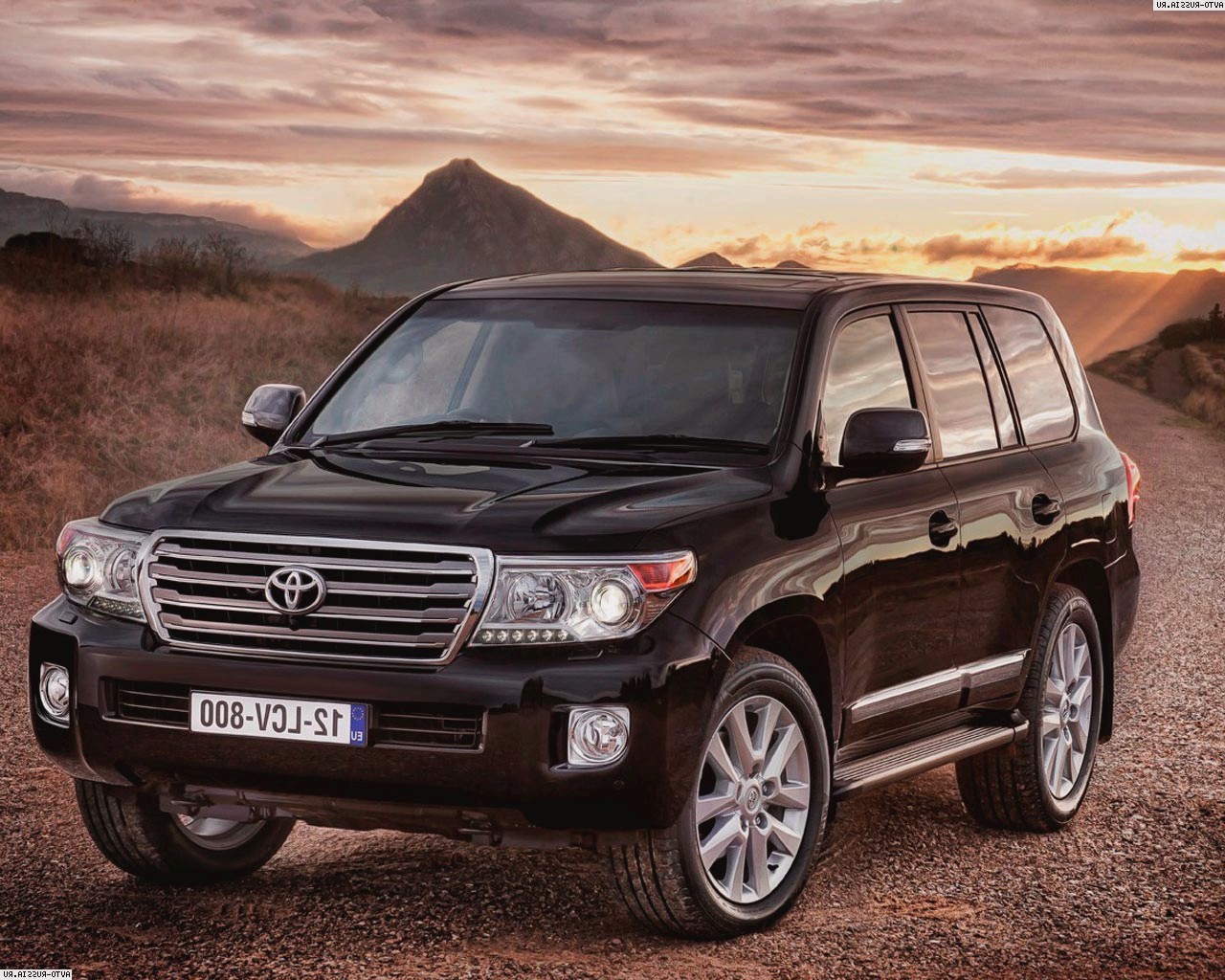
Two types of power units were installed on the Land Cruiser 100 modification: an eight-cylinder V-shaped 4.7-liter 2UZ-FE gasoline engine with a capacity of 235 hp. as well as a six-cylinder in-line diesel engine 1HD-FTE 4.2 l, 205 hp.
Of the novelties among the components and assemblies, one can note the steering rack instead of the worm, as well as the independent front suspension on double levers. Improved comfort and stable handling have been achieved through the use of the Skyhook TEMS system and the ANS hydraulic clearance control system, which greatly help to improve the car's behavior when driving on paved roads. The exterior of the car is very representative: a large hood, two-stage multi-reflective optical elements are installed in the headlights, the bumper is made solid and it is largely bent on the sidewalls, the wheel arches look very powerful, this is facilitated by their protrusion outward, a significant area of glazing and, of course, wide doorways.
Non-woven materials are used in the upholstery of the roof. The roof of the car can be made in several proposed options: with the installation of a folding electric sunroof, a sliding type electric sunroof, with a console on the ceiling to accommodate a variety of small things.
A lot of safety equipment and options are provided, including power brakes, power steering, anti-lock braking system (ABS), front airbags, head restraints for all seats, etc. of course, three-point seat belts with pretensioners. As standard, the car is equipped with a central lock, mirrors and windows with electric drives, a climate control system, a cruise control system, two electrical outlets, cup holders and many different compartments designed to transport and store all kinds of items, a car radio installed in the center console, an immobilizer, heat-absorbing tinted glass, and, of course, alloy wheels. Optional equipment includes central locking with remote control, air conditioning system, CD changer, wheel disks light alloy, etc.
Although the equipment of the 100th Land Cruiser model significantly brings it closer to the class of conventional cars, but, nevertheless, it remains in the eyes of many drivers a real SUV. It is for such people that Toyota has released a new Land Cruiser 105 model.
2001 was an anniversary year for Toyota, of course, because it turned half a century old. During all this time, according to the company's marketers, about four million cars have found their owners. Therefore, it is not surprising that in honor of this significant event, a whole special new series, the 50th Anniversary, was released to the delight of connoisseurs of this iconic car. The differences between anniversary copies and ordinary production cars are quite significant, these are wheels with chrome rims, an anniversary emblem on the body, steering wheel trim in leather and wood, special door sills and logos in a golden hue, a wood-trimmed gear shift lever, upholstery in leather color Ivory. Very few copies were produced in this design, and only 400 units entered the Russian market.
But already in 2007, a new series comes out again - Land Cruiser 200. Continuing all the traditions of their predecessors, the new items still combine both reliability and comfort, not to mention functionality. dimensions increased again, now the length has increased by 60 mm, by 30 mm in width, and of 15 mm in height. But these changes did not affect the recognition of this family.
Enlarged headlights and some body elements, along with an updated grille, gave the car even more massiveness and create a feeling of even greater reliability.
The Land Cruiser 200 co-platform is also the Lexus LX 570 presented to the general public in New York at the auto show. The interior trim of the Land Cruiser 200 is so rich that it can be considered the standard of comfort and luxury. Only standard equipment includes leather and wood trim, four-zone climate control system, navigation system with Bluetooth, premium audio system, rain sensor, immobilizer and 14 driver and passenger airbags! To achieve a feeling of maximum comfort, every detail of the interior is thought out, so that even the most demanding customers will be satisfied. On the Russian market the car is delivered only in a luxury version. It includes 17-inch alloy wheels, a light sensor with automatic headlights on his command, an intelligent system that is responsible for getting into the car and starting the engine, a leather-trimmed steering wheel with remote control buttons. Leather trim is the hallmark of this car, it is so high quality. Two rows of front seats are electrically heated, and the front row is completely equipped with electrical adjustment and a memory function for the driver's seat. The four-zone climate control system is the best in its class, also complemented by dust filters. The display of the navigation system can be used to display the image from the video camera to facilitate parking. The communication system includes a Bluetooth™ interface and a hands-free headset. All technical stuffing is fully consistent with the appearance of the car.
Being the most real off-road vehicle, Land Cruiser 200 has a dependent rear suspension and frame structure of the body, the rigidity of which, in comparison with previous versions increased markedly. The type of front suspension has also changed, it is now exclusively independent and spring, before it was torsion bar. The Crawl Control system is also used, which is responsible for the distribution of torque and braking force between the wheels, which greatly helps the car overcome areas with loose sand, mud or snow. This system helps to maintain the set speed by automatically adjusting the brakes and the power supplied by the engine. This allows the driver not to get lost in difficult traffic conditions and pay more attention to steering, and the system will take care of the rest. In addition to this, the car also has a Multi-terrain ABS system, it can independently recognize the type pavement and based on these data independently selects the mode of operation of the ABS. The car can be equipped with a gasoline eight-cylinder 4.7-liter engine with a capacity of 288 hp, which is complemented by a five-speed automatic. The power unit fully meets all modern requirements, it is also equipped with an electronic variable valve timing system - VVT-i. And to increase traction by low revs and to improve throttle response at high speeds, a variable geometry intake system was used.
The maximum speed of the car reaches 200 km / h, and it accelerates to hundreds in 9.2 seconds, excellent results for an SUV. This V-shaped engine is fully compliant with Euro 4 standards.
The second engine, which can be installed on a 4.5-liter turbodiesel car with a capacity of 235 horses, is complemented by a six-speed automatic. Acceleration to hundreds with such a unit is only 8.6 seconds, and maximum speed reaches 210 km / h. Such impressive thrust is provided by a modern variable geometry turbocharger, as well as fuel system common rail. For the American market, a version with a 5.7-liter engine is also offered. All gearboxes used have excellent performance, they are both very economical in terms of fuel and are distinguished by impeccable smoothness. They have a sequential mode, and also feature AI-SHIFT technology, which automatically selects the optimal gearshift mode that is fully consistent with the driving style of any driver and road surface conditions.
Nowadays, an SUV, in addition to a powerful engine and all-wheel drive, must be equipped with various auxiliary electronic systems that would help the driver even in the most dangerous moments. Therefore, the 200 boasts the following list of such equipment: ABS system, traction control system, stabilization system, DAC hill-descent assistance system, HAC hill-climb driver assistance system. It is also worth mentioning the Torsen LSD limited slip differential installed in the transfer case of the car. The torque can now, without any electronic intervention, be distributed between the axles, although this ratio cannot exceed 30:70.
200 is an excellent off-road vehicle, which, along with excellent handling, has a very rich equipment and comfortable lounge, surpassing all its predecessors in these parameters.
"Toyota"-jeep - this phrase has long become a household name, an appellative that characterizes one of the most famous car brands. The lineup of the legendary car is really impressive. The most popular in 2014 are: Toyota Fortuner, Toyota Land Cruiser 200 and Toyota Land Cruiser Prado.
The Toyota brand (Jeep) includes enough models to lead the world market. The advantages of Japanese SUVs are undeniable, the cars have proven themselves from the best side.
Worldwide Japanese cars are in high demand, among them is the Toyota jeep. All models of this brand, presented in the list, are an example of reliability and comfort:
- Toyota 4Runner;
- Toyota Blizzard;
- Toyota Land Cruiser 200;
- Toyota Highlander;
- Toyota Land Cruiser Cygnus;
- Toyota Land Cruiser Prado
- Toyota Fortuner;
- Toyota Hilux;
- Toyota Venza;
- Toyota Siquoia;
- Toyota RAV4.
There are only a few brands of cars in the world for which the year of manufacture does not really matter, since the margin of safety and resource of such cars is very high. Jeep "Toyota" belongs to the number of such SUVs. All models of this brand that exist today, as well as promising developments, are the dream of many motorists. The cost of the car is high, but the price reflects the equally high reputation of a stylish all-terrain vehicle.
Specifications
"Toyota" - a jeep SUV - is a super reliable car with a very powerful engine, 6-speed automatic transmission and all-wheel drive. The frame structure of the undercarriage provides the machine with stability and a significant margin of safety.
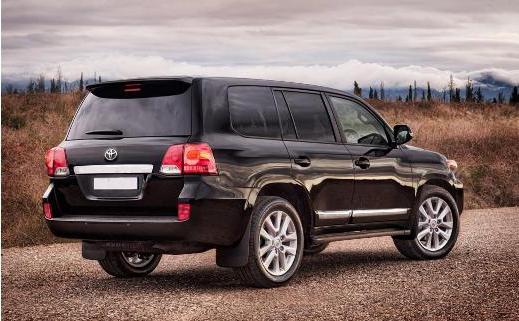
The Toyota lineup (jeep) is constantly updated with new modifications. However, the improvements in the basic design are not revolutionary, all innovations are applied by the company's engineers with caution. That is why there are "untouchable" machines that are included in the lineup"Toyota" (Jeep) as representatives of the Toyota brand, and they are not subject to drastic changes. All Japanese off-road vehicles are distinguished by their magnificent design, impressive dimensions and power.
Jeep "Toyota Land Cruiser"
"Patriarch" of Japanese off-road vehicles, large-size all-wheel drive vehicle. The chrome-plated "toothy" grille instantly makes it clear that this is none other than the legendary Toyota Cruiser jeep, which has withstood 35 years of continuous production since 1980. There were only a few modifications:
- "Land Cruiser 100";
- Land Cruiser 200.
The latest model has become one of the most popular and is in high demand these days.
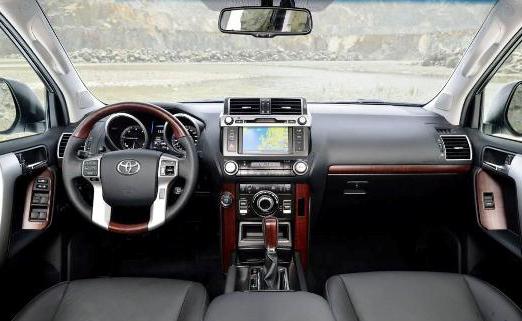
Engine
The base "Cruiser" is equipped with three engines to choose from - two petrol and one turbodiesel. Gasoline are divided into two options: one with a volume of 2.8 liters, develops a power of 159 liters. with., the second - with a volume of 3.8 liters, with a capacity of 280 hp. The diesel engine has a cylinder capacity of 3.0 liters and a maximum power of 172 hp. with.
Transmission and running gear
Almost all Toyota SUVs (jeep) have a 5- or 6-speed automatic transmission gears. A manual gearbox is installed only on the weakest Cruiser with a 2.8-liter engine.
The undercarriage of the car consists of an independent front suspension and rear axle with differential. All wheels are equipped with ventilated disc brakes. Steering with hydraulic booster.
Salon
The interior of the Cruiser is made in a restrained style, nothing more. However, the interior looks quite stylish. Steering wheel on four spokes, the instruments are deeply recessed into the panel, the handles of auxiliary devices are rationally located, the center console is trimmed with valuable wood.

Cruiser 200"
The next model based on the Land Cruiser was the Toyota Land Cruiser 200. It was the same even more stylish and charismatic. The rectangular shapes of the new car corresponded to the fashion of the time when the "200" rolled off the assembly line. This happened in 2007. The front end was decorated with a new chrome plated with horizontal bars. The car featured an elongated rear overhang, uncharacteristic of Jeeps, but in this case, the new contours looked quite organic.
Power point
The Land Cruiser 200 was equipped with V-shaped eight-cylinder units: gasoline, 4.6 liters, 310 hp. with. and diesel, with a volume of 4.5 liters, developing a thrust of 235 liters. with.
The transmission on the 200th Cruiser was in one version: a 6-speed automatic transmission.
All chassis, suspension, brakes and steering got new car without changes. However, the interior has been updated, the instrument panel has changed lighting, the main console has become wider and accommodates several new instruments.
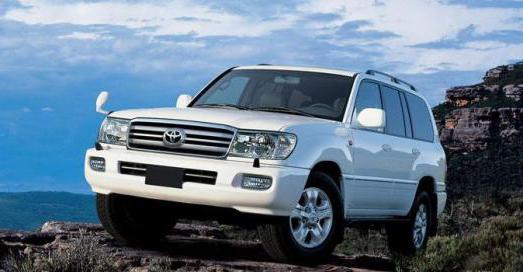
Model "Prado"
1987 on automotive market a mid-size Japanese SUV appeared. With a sufficiently high level of comfort, the new model impressed with its cross-country ability. The first generation Prado was produced in two versions: three-door and five-door. Both models were equipped with both petrol and diesel engines and were put on sale under the name Light Land Cruiser for nine years.
The second generation of the Cruiser Prado model - index 90 - was produced from 1996 to 1999. The car differed from its predecessors in smooth contours with impressive dimensions, good handling and a high level of comfort. On the model "Prado 90" for the first time tested an independent front suspension. The second generation Cruiser Prado is still considered the best in operation in terms of cost indicators and relatively inexpensive maintenance.
The power plant seemed to be rather modest in terms of characteristics, the engine power did not exceed 178 hp. with. Four-wheel drive The car worked with a permanently engaged differential, which was blocked when driving on slippery and wet roads, while significantly increasing the stability of the car.
In the summer of 1999, Toyota carried out a deep restyling of the Prado 90 model. The changes affected the grille and both bumpers, dashboard and trim. All configurations included the installation of automatic transmission, Active Traction Control traction control and VSC balance control.

The third generation of the jeep "Toyota Prado 120" was presented at the Paris Exhibition in autumn 2002. The new model combines Japanese build quality with European design. The deluxe package includes several modern systems, including electronic "assistants" that work when descending on steep slopes, a course stability system (VSC), electronic control front suspension, very useful traction control system A-TRC, softening the initial tractive effort of the transmission.
The same package includes a complete set of electric drives on the door windows, climate control with layered separation, the ability to remotely control the air conditioner from the rear seats.
In 2009, the fourth generation of the Land Cruiser Prado 150 was presented at the Frankfurt Motor Show. increased. The length was 4760 mm, height - 1880 mm, width - 1885. Wheelbase repeated the parameters of its predecessor and remained in the value of 2790 mm. The ground clearance of the car did not exceed 220 mm, which is clearly not enough for an SUV, but the low landing of the car contributed to stability.
Brakes "Prado"
Off-road vehicles are operated, as a rule, in an extreme situation, sometimes requiring an instant stop. The Cruiser Prado is equipped with a brake force fine-tuning system that brings all wheels to the same stopping ratio. When you press the pedal, a special program equalizes the hydraulic supply from the master cylinder. Regardless road conditions, the car stops "still in its tracks" precisely due to the uniform distribution of braking forces.
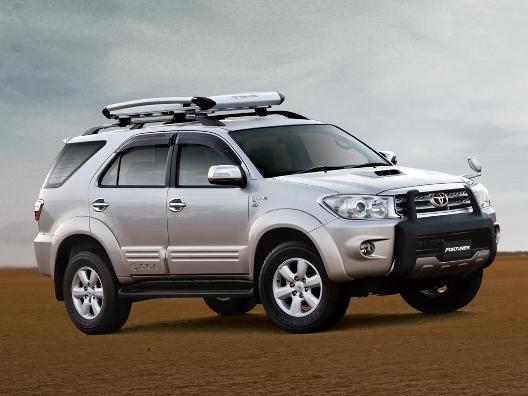
"Toyota Fortuner"
In 1990, the Toyota family of SUVs was replenished with a novelty. On the basis of the Land Cruiser, another model was created - Fortuner, which is somewhat different from the classic Land Cruiser. The release was launched in Thailand in the late 90s, and initially the car was offered only in a rear-wheel drive version. Demand was sufficient for the further development of production, and "Fortuner" began to be sold throughout the southeast region, including Indonesia. Then the car began to develop the Argentine market, and very successfully.
The Fortuner engines repeated the already familiar set - one 2.7-liter engine with a capacity of 170 hp. with. and 4-liter, 280 liters. with.
The car has a spacious comfortable interior, high seats provide good review, the center console is equipped with all necessary travel instruments, clinometer, compass, thermometer, altimeter and barometer.
Jeep "Toyota": price
Cars of the Jeep Toyota brand are sold in Russian car dealerships at prices ranging from 1,794,000 to 3,000,000 rubles, depending on the model, year of manufacture and configuration.
After World War II, Japan really lay in ruins - in 1946, a card system was even introduced in the country, which made it possible to obtain a strictly defined amount of food and material wealth. However, the enterprising Japanese did not give up, on the contrary, they began to look for profit in their defeat. One of the first to respond was Toyota, which offered the American Expeditionary Forces an SUV, later called the Land Cruiser. Understand how the utilitarian managed to go the way that made it prestigious modern car, the history of the Toyota Land Cruiser model will help us.
Toyota Land Cruiser car - the brainchild of the post-war period
Emergence of the model
The first prototypes of the car, later called the Toyota Land Cruiser, appeared back in the late 40s - the car was an almost complete copy of the Willys MB, which was the predecessor of all Jeeps. However, the real history of the Land Cruiser began in 1953, when mass production military model. Toyota SB truck units were used as the base chassis, which made the car incredibly durable and. In addition, the future Land Cruiser also got the engine from the truck - the six-cylinder assembly of the B series had a capacity of 86 horsepower with an actual working volume of 3.3 liters. Due to the high power and excellent traction capabilities of this unit, Toyota engineers completely abandoned the transfer case, reducing in this way.
Thanks to the name of the engine, as well as the internal designation of the SUV, like Toyota Jeep, it went into the series under the name BJ. Despite the fact that at first the transport was intended for the US military, they had already significantly reduced their presence in Asia and were not very interested in Toyota. As a result, out of 298 vehicles, most were purchased by the police, as well as the forestries of Japan. In addition, several SUVs were given to the company's employees for private use, which led to the appearance of a civilian version of the Toyota Land Cruiser.
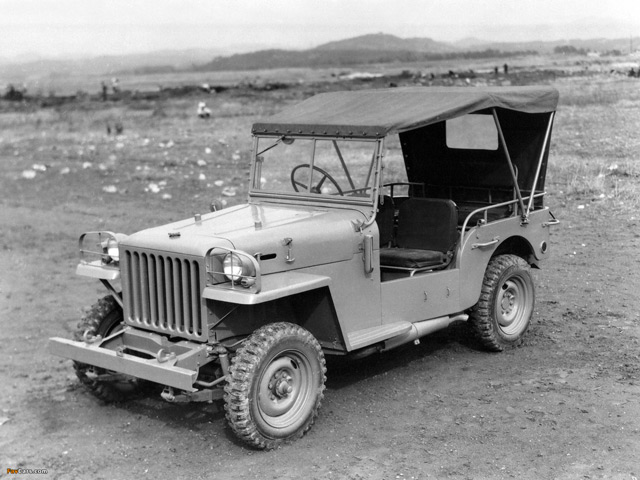
By 1954, Toyota began to think about selling its SUV - however, an obstacle to this was the claim made by Willys, which prohibited the use of the Jeep name even as part of the abbreviation. It was necessary to urgently come up with a sonorous name that would allow the car to be promoted in foreign countries - as a result, Toyota announced a competition. It was won by technical director Hanji Umekara, who suggested the Land Cruiser name. In his opinion, this name was associated with world famous ones, and also spoke of the military past of the model, since Cruiser is translated as "cruiser". It was decided to assign this name to a new civilian vehicle, while the utility SUV was still produced for domestic market under the name Toyota BJ.
The beginning of popularity
In fact, the history of Toyota Land Cruiser begins in 1955, when the first car with the BJ20 index was created. It was much more comfortable than the military modification due to the following changes:
- Full metal body for the first time for Land Cruiser;
- Changed trim materials and seat upholstery;
- The presence of a full-fledged, equipped with all the necessary indicators.
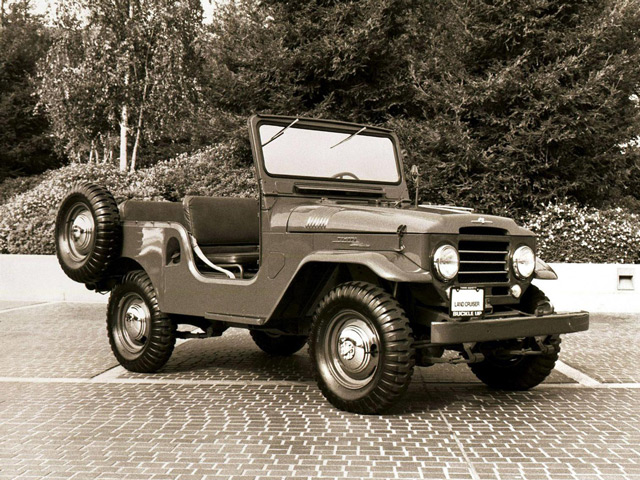
Moreover, in design Toyota body Land Cruiser appeared soft lines that made the car look like. Initially, the car was sold only in Japan, but then branded offices were opened in South America, the USA and South Africa. Subsequently, deliveries were made to almost all continents of the Earth.
By the end of the 50s, the SUV index changed - now it was called the Toyota Land Cruiser FJ20 - the reason was the F series, which, with a four-cylinder displacement of 3.8 liters, developed an actual power of 105 horsepower. Around this time, the previous army "jeep" was discontinued, as a result of which government services began to form orders for the civilian Toyota Land Cruiser. To best meet their needs, ten different modifications of the vehicle were created, which differed in wheelbase size, body type, and even the transmission used. Indeed, during this period, rear-wheel drive Land Cruisers were produced, which entered the service of the city police. Based on this vehicle, the Toyota Land Cruiser FJ35V station wagon was created, which had an elongated rear overhang that could accommodate a lot of luggage.
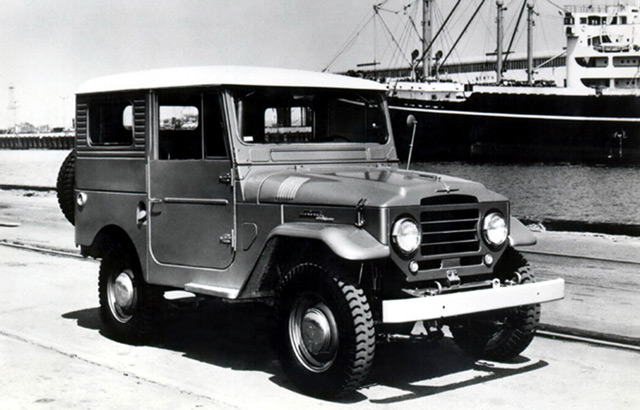
Growing up model
However, the Japanese realized that with such a model, which in its essence remained simple and utilitarian, they would not achieve much success. Therefore, in 1960, production of the Toyota Land Cruiser FJ40 began, which already had a reduction gear in the transmission, and also had an improved interior trim. He also received several modifications, which were to bring him success in overseas markets. In particular, the Land Cruiser was produced, equipped with three and five doors, in three wheelbase lengths, with station wagon and. Especially for the USA, an elongated modification of the FJ45V was developed, which had the highest possible comfort. Also, buyers had a Toyota Land Cruiser with a hard steel roof, plastic or fabric soft top.

Transition to luxury
In 1989, the Toyota Land Cruiser 80 generation appeared, which was already deprived of an index indicating the type of engine used. The car corresponded in terms of equipment to a typical business class sedan of those times, the available options included air conditioning, an audio system with a large number of speakers and other means of improving comfort. In addition, since 1996, all the basic configurations of the Land Cruiser 80 have included such as two airbags and ABS.

The history of the Land Cruiser of that time includes the appearance of the first car with independent front suspension - it was the car of the 90th series with a prefix to the Prado name. Unlike the 70 series, it is not built on the chassis of the "senior" Land Cruiser, but on the basis of the Toyota 4Runner, which made it possible to significantly reduce the weight of the vehicle. Buyers Toyota Prado they could choose between a gasoline engine (3.4 liters, 190 horsepower) and a diesel engine (3.0 liters, 125 horsepower). In addition, only a simplified transmission was provided for this version of the Land Cruiser, which made it more suitable for driving on a flat road than on rough terrain.
Modernity
The next update of the range of vehicles under the name Land Cruiser took place in 1998, when modification 100 was released, which could already be considered a luxury car. Thanks to excellent equipment, as well as excellent dynamic characteristics, she received from wealthy people who made very high demands on a personal vehicle. Once again, the range of Land Cruiser engines has undergone refinement - now buyers had a choice between gasoline unit V8 4.2 (272 horsepower), as well as a diesel inline six-cylinder engine of the same volume, which developed a power of 202 horsepower.
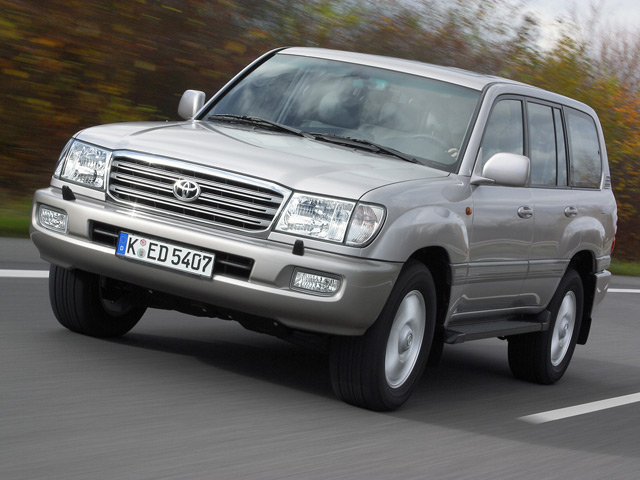
Most versions of the Toyota Land Cruiser 100 were equipped with independent front suspension, however, specifically for people in need of a utility vehicle, the 105 series was released with a fully dependent chassis. In 2003, the Toyota Land Cruiser Prado 120 series was introduced to the public - it was still based on the 4Runner lightweight chassis, but now it was available gasoline engines volume of 4.0 liters (250 horsepower) and 2.7 liters (165 horsepower). In size, it was slightly smaller than the "older" model and was distinguished by a modified design.
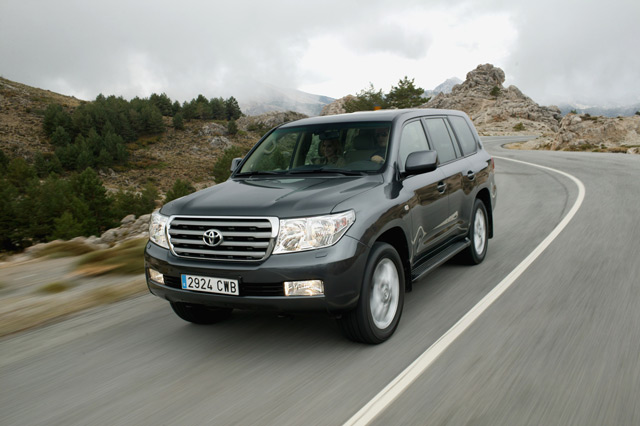
In 2007, it came out significantly, which was now called the Toyota Land Cruiser 200 - it received an updated design and an expanded list of equipment, and also differed in significantly increased dimensions. The range of engines has also seriously changed - the base now has become a V8 with a volume of 4.6 liters and a maximum performance of 309 horsepower. Besides, vehicle can be ordered with a 4.5 diesel engine, whose performance is 235 horsepower.
Video about history Toyota car Land cruiser:
Two years later, the updated Prado came out, which followed the Land Cruiser 200 in its changes. The car increased in size, and also became more prestigious and comfortable. In addition, the list of engines has expanded, which were now represented by the following units:
- Gasoline 2.7 liters - 163 horsepower;
- Diesel 3.0 liters - 173 horsepower;
- Petrol, 4.0 liters - 282 horsepower.
Half a century of history
Despite the appearance latest models, not only "hundreds" and "eighties" are popular, but also the Toyota Land Cruiser of the former 60th series. The car is famous for its reliability, comfort and excellent cross-country ability. If we talk about modern generations of Toyota Land Cruiser, then they have practically no competitors - all other SUVs are either much more expensive or significantly behind them in terms of performance.
